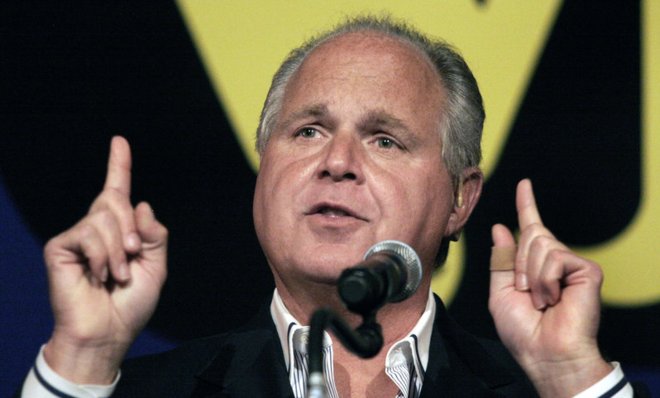How country, NPR, and Limbaugh are keeping radio alive
Good ol' terrestrial radio isn't dead yet, thanks to an odd combination of talkers and country rockers


On Thursday, Nielsen released its annual "Audio Today" report, a look at the health and trends of "the original mass medium, radio." Among its findings, 242 million Americans listen to the radio each week, with 64 percent of listening time outside of the home and 62 percent of listeners (age 18 to 64) full-time workers. We mostly listen in our cars and at work. There are more than 16,000 radio stations nationwide spanning 50 different formats.
There are a lot of different numbers in the report. But two stand out: 14.8 percent of the radio we collectively listen to is on country music stations and 11.3 percent is news/talk radio. None of the other formats cracks double-digit saturation. Country is the top choice of millennials (ages 18-34) and members of Generation X (ages 35-49). The baby boomers (ages 50-64) favor news and talk radio.
Collectively, these 171 million millennials, Gen Xers, and boomers make up more than 70 percent of the radio audience. "One of radio's best-kept secrets is its ability to reach a highly qualified audience right before they arrive to shop," Nielsen notes, none to subtly. "And audio consumers have money to spend because more than two-thirds of the weekly audience works full-time."
The Week
Escape your echo chamber. Get the facts behind the news, plus analysis from multiple perspectives.

Sign up for The Week's Free Newsletters
From our morning news briefing to a weekly Good News Newsletter, get the best of The Week delivered directly to your inbox.
From our morning news briefing to a weekly Good News Newsletter, get the best of The Week delivered directly to your inbox.
That the biggest chunk of these employed, ad-listening 18- to 49-year-olds are listening to country music may surprise you — Nielsen doesn't break out how much of this is regional, reflective of the relative popularity of country music, or indicative of what subgroups are tuned in to the radio — but at least country music is an easily defined category.
News/talk is a little more nebulous, and Nielsen doesn't break it down (although all-news radio gets its own format, drawing 1.5 percent of traffic). Luckily, the Pew Research Center includes an audio section in its annual State of the News Media report, and it has some numbers. Pew's 2013 report matches up pretty well with Nielsen in terms of the percentage of people who listen to the radio at least some each week (92 percent), and what they listen to:
According to Pew's report, 26 million Americans listen to NPR each week, not counting its growing online and mobile audience. (Pew also says that at least 14.5 million people listen to American Public Media [APM] and 11.6 million listen to Public Radio International [PRI] each week — but since most of their content is aired on NPR affiliates, I'm going to use NPR's numbers as the metric to measure public radio's audience.)
A quick back-of-the-envelope calculation suggests that NPR's 26 million listeners make up 10.7 percent of Nielsen's 242 million total listeners. The other big segment of the news/talk universe is, of course, talk radio, where Rush Limbaugh is still king, drawing 14.75 million viewers each week. Sean Hannity is close behind, at 14 million. Pew has the rest of the Top 10:
A free daily email with the biggest news stories of the day – and the best features from TheWeek.com
"Roughly one out of six people tune in to hear Limbaugh at least sometimes (16 percent), roughly half as many people who listen to NPR as often," Pew says. That doesn't contradict Nielsen — Limbaugh is only on for a few hours each day, and the 11.3 percent number represents how much time people spend listening to each format; if a third of people listen to NPR sometimes, Americans spend more time with the radio tuned in to country music.
But collectively this mess of numbers tells us one thing pretty clearly: When people listen to the radio, what they're most likely listening to is country music, NPR, or Rush Limbaugh.
Why does that matter? Advertisers spent $14.2 billion on AM/FM radio ads in 2012, Pew reports, or 86 percent of all radio ad buys (online, satellite, and podcasts make up the rest). NPR stations raise tens of millions more each year from pledge drives, gifts, and sponsorship deals.
Pop, rock, and hip hop get most of the attention in the popular press. On the radio, they appear to be an afterthought.
Peter has worked as a news and culture writer and editor at The Week since the site's launch in 2008. He covers politics, world affairs, religion and cultural currents. His journalism career began as a copy editor at a financial newswire and has included editorial positions at The New York Times Magazine, Facts on File, and Oregon State University.
-
 Political cartoons for January 4
Political cartoons for January 4Cartoons Sunday's political cartoons include a resolution to learn a new language, and new names in Hades and on battleships
-
 The ultimate films of 2025 by genre
The ultimate films of 2025 by genreThe Week Recommends From comedies to thrillers, documentaries to animations, 2025 featured some unforgettable film moments
-
 Political cartoons for January 3
Political cartoons for January 3Cartoons Saturday's political cartoons include citizen journalists, self-reflective AI, and Donald Trump's transparency
